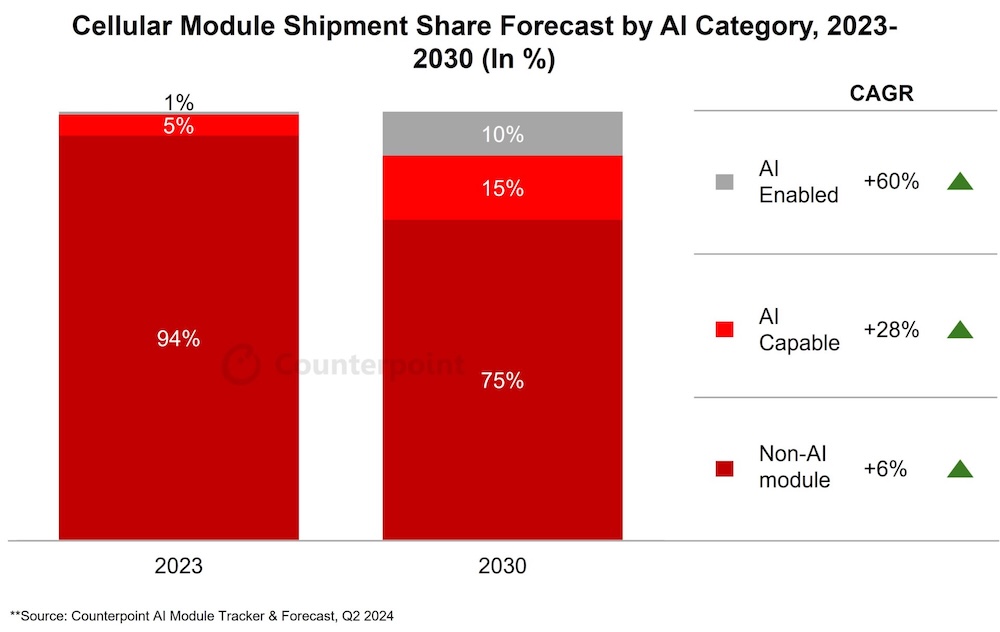They accounted for 6% of total cellular IoT module shipments in 2023 but are set to grow at CAGR of 35% until 2030
AI-embedded cellular modules are projected to comprise 25% of all IoT module shipments by 2030, up from 6% in 2023, with a CAGR of 35%, according to analysts Counterpoint. These modules have advanced from simple baseband components to AI-enabled SoCs that integrate CPU, GPU, and NPU to boost functionality and performance. Counterpoint suggests the processing battle at the edge with be driven by application such as drones, automotive, POS and retail, healthcare, robotics and industrial.
As a result, this could provide a relatively new market opportunity for service providers – although these may not necessarily be telcos – given that demand for on-device AI is rising due to the focus on local analysis, real-time decision making, and enhanced security. Samsung has already stimulated the handset market by backing on-device AI and the IoT world is ripe for exploiting the technologies.
The arguments are well-rehearsed. Because data is processed within the user device, on-device AI provides improved latency. And by doing away with a centralised server, on-device AI solves the security issues that have been pointed out for cloud-based AI. The ability to provide AI services without a network connection means real-time translation and other tasks can be performed even without an internet connection. But there is a more compelling reason too – it isn’t feasible to have millions of remote devices all trying to reach a remote AI data centre.
A recent report by 5G Americas with analysts Omdia reflected the IoT bullishness stating that global IoT subscriptions currently stand at 3.4 billion. As 4G LTE-connected IoT devices are upgraded to flexible 5G-enabled IoT technologies, such as 5G RedCap (Reduced Capability), new enhancements offer network operators benefits such as improved energy and network efficiency. Due to these improvements, global forecasts suggest IoT subscriptions will reach 5.2 billion, while smartphone subscriptions will surge to 8.2 billion by 2029.

Market shape
AI has evolved significantly in recent times, particularly in areas like privacy, reliability, low latency, cost-effectiveness, energy efficiency, and personalisation. Counterpoint categorises IoT modules further based on their hardware integration capability and use cases.
The first category is basic cellular modules which include only a baseband or chipset and primarily provide connectivity for IoT devices to send and receive data. The second is AI-capable modules (smart modules), which feature a CPU and GPU along with connectivity baseband, with a primary focus on connectivity and basic data processing. The third is AI-enabled modules, which go a step further by incorporating advanced processors such as a CPU, GPU, and a Neural Processing Unit (NPU) or Tensor Processing Unit (TPU), or a dedicated AI engine for enhanced AI capabilities. These can be low- or high-level AI modules with the latter supporting AI inference above 8 TOPS.
Counterpoint said that in the automotive industry, the rise of digital cockpits will significantly boost the adoption of AI-embedded cellular modules. AI-powered virtual assistants enhance the driving experience by responding to voice commands, managing navigation, and controlling in-car entertainment systems such as music and video.
In POS and retail systems, smart displays with AI-capable modules are increasingly adopted. As AI features like face detection and gesture recognition grow, both low and high-level AI cellular modules are integrated, aiding in customer behaviour analysis, inventory management and fraud detection.
In the future, AI-equipped routers could act as central hubs for managing smart home devices like lights, thermostats, and security systems. However, Counterpoint suggested the adoption of these AI-enabled routers will be limited.
Apart from these applications, the market will witness the adoption of AI-embedded modules in drones, rugged handheld devices, robotics, digital signage, security cameras, and more. “We expect AI-embedded modules to be most adopted in drones and rugged handheld devices, though volumes will remain niche. Meanwhile, the automotive and POS sectors are expected to contribute the most to the overall AI-embedded cellular module shipments by 2030,” said Counterpoint.
Examples are emerging
A good example of how far the market has moved is down to emerging products from the likes of Chinese company Fibocom. In June, it launched a series of on-device AI solutions powered by Qualcomm QCS8550 and QCM6490 processors which are designed to satisfy compute-intensive application scenarios such as robotics, automated vehicles, video collaborations, smart retailing and so on.
Equipped with an octa-core CPU and an Adreno 740 GPU, the solution can support up to 4 concurrent displays, and 8K video encoding and decoding. It serves as a strong core for industries requiring high-definition video playing, fast data analytics and lower latency like automated vehicles, robotics, computer vision systems, live streaming and videoconferencing systems.
Last year, Cavli Wireless – which has an IoT partnership with Orange Business – launched its CQS290 smart cellular IoT module at the India Mobile Congress. It runs on an ARM Cortex A53 processor with built-in AI capabilities and Android OS, offering edge processing for AI-driven applications.
There’s plenty of work around keeping on-device AI power requirements down as well. While not strictly IoT, in February, SK Telecom, MediaTek and Nota AI developed a smartphone power-saving technology using on-device AI.
That technology enables the device to predict, in real-time, whether data transmission will occur within a certain period, thereby controlling an optimal connection status between the device and the base station. That is, if the prediction indicates that data is likely to occur, it will continue to maintain connection between the device and the base station. On the other hand, if it thinks that data is unlikely to occur, it will disconnect from the base station to prevent unnecessary use of power.




